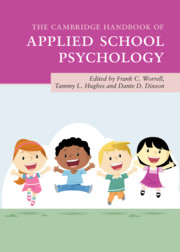Book contents
- The Cambridge Handbook of Applied School Psychology
- The Cambridge Handbook of Applied School Psychology
- Copyright page
- Contents
- Contributors
- Contributor Biographies
- Acknowledgments
- 1 Broadening the Focus of School Psychology Practice
- Part I Individual-Level Academic Interventions
- Part II Teacher- and System-Level Interventions
- Part III Interventions from Educational and Social/Personality Psychology
- Part IV Behavioral and Social-Emotional Interventions
- Part V Health and Pediatric Interventions
- 26 Impairments Related to Medical Conditions
- 27 Psychological Considerations for Asthma
- 28 Substance Use and Misuse Prevention: Guidance for Practitioners
- 29 Coordinating Services with Nonschool Providers
- Part VI Family Connections and Life Transitions
- Part VII Special Populations
- Part VIII Conclusion
- Index
- References
29 - Coordinating Services with Nonschool Providers
from Part V - Health and Pediatric Interventions
Published online by Cambridge University Press: 18 September 2020
- The Cambridge Handbook of Applied School Psychology
- The Cambridge Handbook of Applied School Psychology
- Copyright page
- Contents
- Contributors
- Contributor Biographies
- Acknowledgments
- 1 Broadening the Focus of School Psychology Practice
- Part I Individual-Level Academic Interventions
- Part II Teacher- and System-Level Interventions
- Part III Interventions from Educational and Social/Personality Psychology
- Part IV Behavioral and Social-Emotional Interventions
- Part V Health and Pediatric Interventions
- 26 Impairments Related to Medical Conditions
- 27 Psychological Considerations for Asthma
- 28 Substance Use and Misuse Prevention: Guidance for Practitioners
- 29 Coordinating Services with Nonschool Providers
- Part VI Family Connections and Life Transitions
- Part VII Special Populations
- Part VIII Conclusion
- Index
- References
Summary
School psychologists often need to coordinate student support services with nonschool providers to fully address nonacademic (e.g., physical health) areas of concern, to enhance student functioning in a comprehensive and consistent fashion, and to share data regarding school performance and inform evaluation and modification of community support services. This chapter provides an overview of current knowledge and best practice guidelines for communicating and coordinating services with nonschool providers. We describe theoretical models (e.g., social-ecological) that can guide practice, and discuss service coordination in the context of a multitiered system of support. A continuum of care is proposed, including collaborative implementation of prevention services (e.g., screening, health education), and the use of conjoint behavior consultation to deliver targeted and individualized interventions in collaboration with nonschool providers. The chapter concludes with a discussion of possible barriers to service coordination and recommendations for addressing these barriers.
Keywords
- Type
- Chapter
- Information
- The Cambridge Handbook of Applied School Psychology , pp. 500 - 516Publisher: Cambridge University PressPrint publication year: 2020



